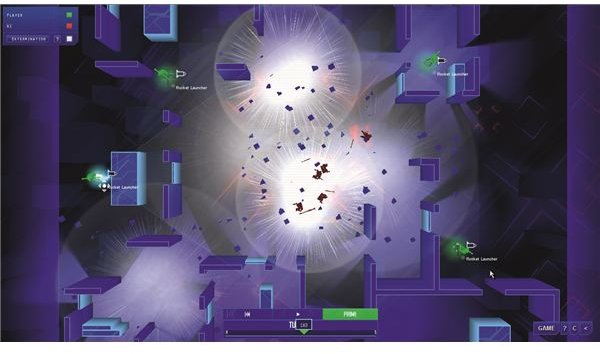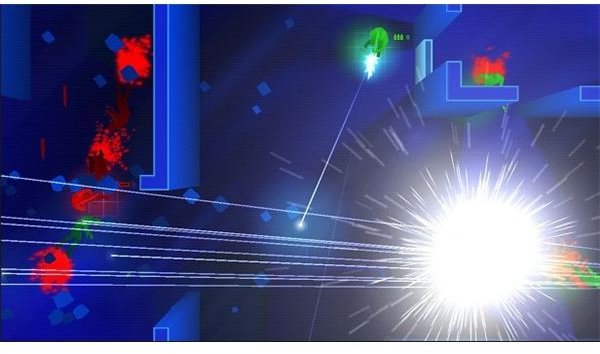Frozen Synapse Review: Upsetting the Turn Based Strategy Genre

Gameplay (5 out of 5)
It’s no secret that turn-based tactical games can be frustrating. The problem, in many cases, is the inability to understand the consequences of your actions. You make your moves, you send in your troops, and suddenly they’re all dead. Why? The feedback a game gives you is important, because if you don’t understand what happened, you’ll probably throw up your hands and quit.
After years of dealing with this problem, we finally have a game with a solution. The turns in Frozen Synapse consist of the “Planning Phase” and the “Outcome.” In the planning phase, the interface allows you to decide everything your units will do. You can pick where they move, when they move, the direction they aim, and more. Normally, you’d simply end the turn when done and see what happens. But in Frozen Synapse, you are given the chance to simulate the turn. If the outcome looks bleak, tweak the plan!
There are only a few types of units in the game, and the randomly generated battlefields – which are meant to approximate the interiors of buildings – begin to feel repetitive quickly. Yet the interactions between the units and battlefields can be complex. A shotgunner might sneak up on a sniper by ducking behind cover, or a rocket trooper might blow down a wall and leave a previously sheltered enemy exposed. Learning the ropes isn’t difficult, but mastering the game is challenging.
Simplicity does have its downsides, however. I found the game much more enjoyable to play in short bursts rather than long, marathon sessions. There isn’t enough variety otherwise, and as engaging as the tactical puzzles can be, they always occur in roughly similar environments with similar units.
Multiplayer (5 out of 5)
While there’s a robust single player game, multiplayer is an important part of Frozen Synapse. Playing against the AI can become old fast, particularly once you’ve beat the campaign, as it becomes a bit predictable.

Mode 7 games has already introduced the turn simulation, which is a game-changing feature – they could have just stopped there. Instead, they went and introduced another revolutionary improvement that changes the way multiplayer turn-based games are played.
In Frozen Synapse, you don’t join a game and play it to completion without interruption. Instead, the game is added to your games list. You can come back to it at any time, even after you quit the game entirely. As long as you join the same server the games are hosted on, your games will persist.
This means there is no pressure to hurry up and finish a turn. You can scheme as long as you’d like, using the turn simulation to try and predict what the other player will do. Then, when you’re done, you submit your turn – and wait for the other player to do the same.
Competitive play is aided by a robust ladder system, stat tracking, and the ability to review games after they’re finished. Unlike many titles, there’s no “care bear” mode. When you play this game, you’re being ranked, like it or not. While a few gamers might dislike that, the fact you can play multiple games at once causes you to quickly forget about any beatings, as you’ll usually be beating someone else in another of your games.
Graphics (4 out of 5)
As the production of advanced 3D graphics has become more expensive, indie studios have turned towards art as a means of standing out from the crowd. An artistically unique game can make up for technical limitations and accomplish much even when on a tiny budget.

Such is the case here. The entire game takes place in a Tron-like reality known as “the shape” which exists simultaneously with the real. Although the battlegrounds of the game are supposedly office buildings, they’re represented by simple blue walls, and units are represented by colored, untextured models. While the background isn’t detail, it pulses with energy and changes color (from dark to light blue) subtly during battle.
None of this is going to leave your jaw resting on your keyboard, but it’s effective, and it keeps the game’s system requirements low without sacrificing visual quality. It’s incredible how can a little creativity can turn simple 3D models into an impressive environment.
Audio (4 out of 5)
Most of the unit and battleground audio in the game is basic, but effective. Each troop’s weapon has a unique sound, so you always know who fired before you see it. The game’s single-player campaign does not, unfortunately, have any voice acting. Although annoying, it was probably better for Mode 7 to ignore it completely than hire sub-par voice actors on a tight budget.
Or perhaps they spent that time and money on the soundtrack, because it’s easily the best game soundtrack I’ve heard in years. It’s good enough for the developer to release the soundtrack independent of the game. Comparisons to music from the Mass Effect series and the original Deus Ex are apt, and that’s some excellent company for an indie game to hang with.
Verdict (5 out of 5)
This game could be a real upset later this year when game-of-the-year lists are being formed. Certainly, it’s the best strategy game to come out in 2011 so far, and it also has the best soundtrack of any game release this year so far.
Frozen Synapse is not an epic game, unlike so many turn-based titles. It is a tight, focused entry into the strategy field that encourages gamers to play whenever they’d like, for as long as they’d like. This might be a problem if the game sold for $40, but like so many indie titles, it’s available for much less – just $25, and it’s already been on sale for a hair under $13.
It’s well worth a purchase at any of those prices, even if you’re not a veteran turn-based gamer. Indeed, this game is easier to learn than almost any other turn-based game I’ve ever played. So you have no excuse for not buying it.
References
Author Experience
Images are from developer press materials
